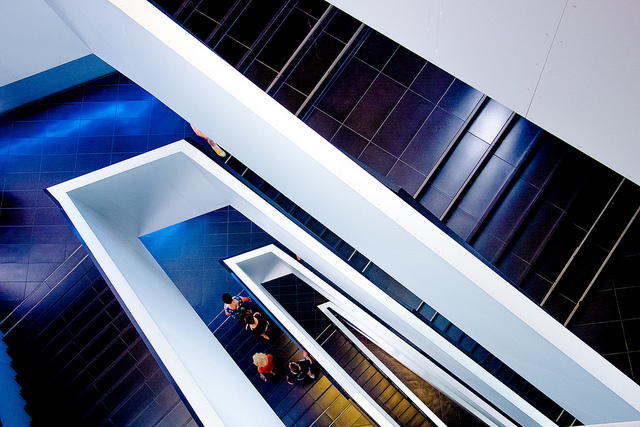Code Green Solutions


Open stairwell at the Royal Ontario Museum
Human built environments aren’t always conducive to physical activity. We drive to work or school instead of cycling or walking, ride elevators and escalators, and engage in sedentary activities for most of the day. Active design looks to encourage physical activity through the design of buildings.
The benefits of active design are myriad: Studies have shown that simply using stairs reduces the risk of stroke, improves cardiovascular health, and reduces levels of cholesterol. Walking, rather than driving, to work or school has also been shown to have significant health impacts, including lower incidence of childhood obesity. Active design can have positive implications for energy use in buildings as well, with increased stair use leading to decreased use of elevators and escalators, which are a significant source of energy usage in commercial buildings (especially high-rises) and are costly to repair and maintain. Reducing reliance on fossil fuel transport – and instead utilizing human-powered transport such as walking and cycling – has obvious environmental and health benefits.
Since 2008 a team of health and design professionals from the New York City Department of Health and Mental Hygiene, the NYC Department of Design and Construction, 1100 Architects, and Atelier Ten have worked to develop and promote a LEED Innovation in Design credit founded in the principles of Active Design. A paper, presented as part of the Greenbuild Thought Leadership & Research Track, indicates that the credit was designed to “enhance the existing LEED building rating systems by incorporating active design strategies for both occupant health and environmental benefits.”
The credit is divided into two main components. The first “aims to promote opportunities for routine stair use, while still keeping in mind the principles of universal accessibility,” and includes strategies like providing accessibility to all floors via unlocked stairways and posting stair prompt signage at elevator call areas. The second “aims at connecting projects to nearby or on-site facilities that provide opportunities for intentional physical activity,” and includes strategies like locating the project within a ¼ mile of a walking trail or recreational space.
Active Design and LEED: Early Use and Analysis of the Innovation Credit for Health describes the frequency of strategies employed in seven examples of diverse building types – including residential, office, academic, and healthcare facilities – that have implemented the Innovation Credit strategies as part of a LEED project. It also discusses the health and environmental benefits expected from their implementation. The study found that stair related strategies dominated, which the authors state suggests a “strong willingness among architects to consider stair use as an important factor in building design and feasibility of incorporating the stair design strategies found within the credit.” The use of slowed down or skip-stop elevators was rarely pursued.
To learn more about Active Design check out the Center for Active Design where you can download the Active Design Guidelines and view case studies of projects implementing these strategies.